Salvador Dali Old Antique Last Supper Lithograph Vintage Modern Christ Religious
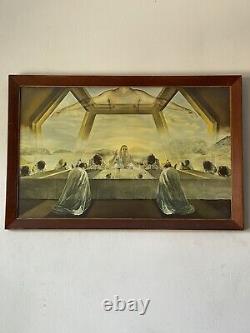
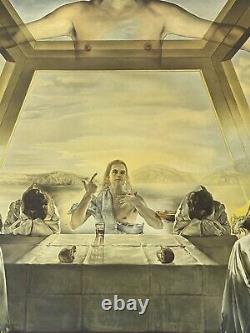
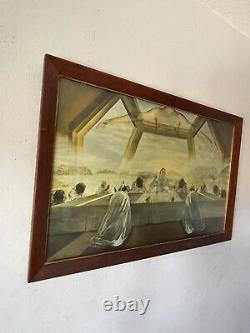
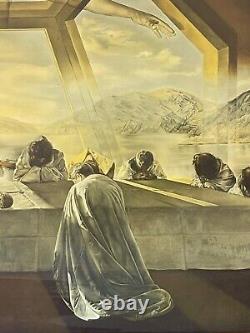
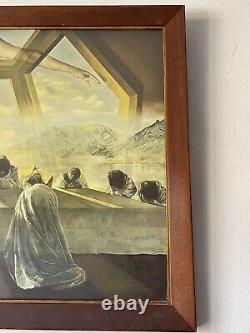
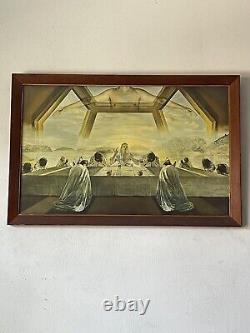
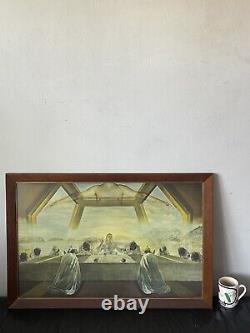
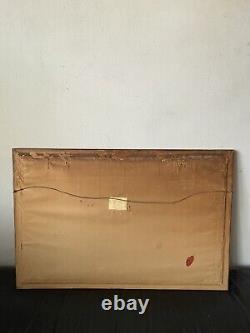
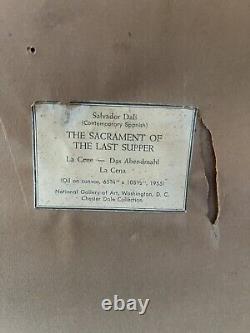
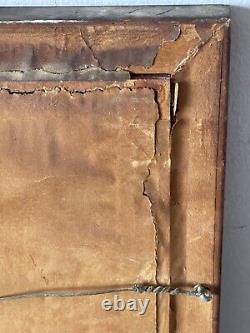
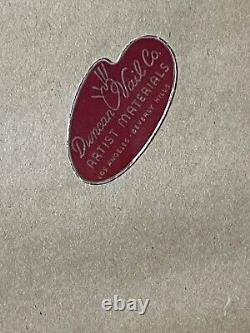
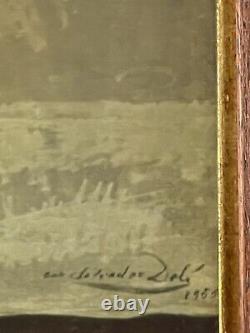

POWERFUL ANTIQUE SURREALIST LITHOGRAPH BY REVERED INTERNATIONALLY KNOWN LEGENDARY PAINTER SALVADOR DALI. THIS WORK IS TITLED: THE SACRAMENT OF THE LAST SUPPER.
THIS LITHOGRAPH DERIVES FROM THE FAMED CHESTER DALE PRIVATE COLLECTION. NATIONAL GALLERY OF ART WASHINGTON DC. PROVENANCE IS ATTACHED TO THE VERSO. IT RETAINS THE ORIGINAL FRAME AND DUNCAN VAIL CO BEVERLY HILLS LABEL. DIMENSIONS: 23"H x 33"W.
Born: 1904 - Figueras, Spain. Died: 1989 - Figueras, Spain. Known for: Surrealist painting, drawing, photography, sculpture. Name variants: Salvador Felipe Jacinto Dalí Y Domenech, Salvador Dali Domenech. It's Christian subject matter, simplicity of organization, and lack of shock value separate The Sacrament of the Last Supper from most of Salvador Dalí's other works. Dalí's reputation from the late 1920s to the mid-1940s was founded on his surrealist manner and use of Freudian dream imagery. This tableau of 1955 is both religious and realistic: the background accurately portrays the view from Dalí's home on the Catalan coast of northeastern Spain. Although the rugged cliffs and eroded boulders of his native Catalonia had inspired many of the fantastic forms in his earlier works, here Dalí used the craggy bay of Port Lligat as a straightforward backdrop.During the late 1940s, Dalí's return to Christian imagery and traditional values was influenced by three factors: the devastating effects of the Spanish Civil War and World War II, his reawakened interest in classical art, and his reappraisal of Freud's psychological principles after meeting the aging psychoanalyst in 1938. One classic derivation cited by Dalí in connection with his painting was Zurbarán, a seventeenth-century Spanish old master. The Italian High Renaissance of the early 1500s was another major source for Dalí's new classicism. As in the harmonious presentation of Renaissance schemes, Dalí's composition is clearly divided: foreground action and background scenery.
The placement of men around the table is symmetrical, the same figure repeated in perfect mirror image on both sides of Christ. Moreover, the entire nine-foot-long picture is constructed according to complex mathematical ratios devised by Renaissance scientists and such ancient Greek philosophers as Pythagoras. Dalí explained the reliance upon this elaborate geometric patterning just after completing nine months of work on the picture.
I wanted to materialize the maximum of luminous and Pythagorean instantaneousness based on the celestial communion of the number twelve: twelve hours of the day-twelve months of the year-the twelve pentagons of the dodecahedron-twelve signs of the zodiac around the sun-the twelve apostles around Christ. Thus, The Sacrament of the Last Supper is not an attempt to recreate the meal but a symbolic presentation of the Eucharistic ritual. Rather than specific apostles, the men at the table are idealized participants. The strange enclosure-part earthly, part celestial-is not the "large upper room" of the Bible, but an abstract concept embodied by the dodecahedron.
Just as the surrounding cupola appears only partially real, Christ is not corporeally present because his body is partially transparent. The more tangible allusion to Jesus' physical presence is the symbolic bread and wine. This ethereal, disembodied torso above him is more youthful than the standard conception of the Creator, who is typically portrayed as an aged patriarch. The wide, outstretched arms might represent the resurrected Christ, but the nail holes are absent from the hands, and the wound does not appear on his side. Perhaps this figure embodies Dalí's idea that heaven is to be found exactly in the center of the bosom of the man who has faith!
Dalí's The Sacrament of the Last Supper was given to the National Gallery by one of its greatest benefactors, Chester Dale, who donated more than three hundred works of art to the museum. He then sent it to the National Gallery, where it was placed on public view the day before Easter in 1956. As Dale put it, This is a picture for all time. It's too important to keep for a few. Dale and Dalí both attended the special preview, and more than seven thousand visitors flocked to the museum to see the painting the first day it was displayed. The friendship between artist and collector was an enduring one. Dalí and his wife, Gala, were frequent guests at the Dale's apartment, while Dale and his second wife, Mary, visited Dalí at his home in Spain.Dale pronounced Dalí "one of the greatest artists of our day, " and Dalí held the collector in equally high regard. Upon learning of Dale's death in December 1962, Dalí mourned the passing of the man he described as "a great patron of the arts, " whom he compared to those of the Renaissance.
Boca Raton Museum of Art (Boca Raton, FL). Community Fine Arts Center (Rock Springs, WY). Kirkland Museum of Fine & Decorative Art (Denver, CO). Kresge Art Museum (East Lansing, MI). Pensacola Museum Of Art (Pensacola, FL).
Print Club of Albany (Schenectady, NY). R W Norton Art Gallery (Shreveport, LA). Southern Alleghenies Museum of Art (Loretto, PA).
Tate Modern/Tate Gallery, London (London, United Kingdom). The Canton Museum of Art (Canton, OH). Museum of Art (Norman, OK). The Grace Museum (Abilene, TX).The Phillips Museum of Art (Lancaster, PA). University of Wyoming Art Museum (Laramie, WY). Washington County Museum of Fine Arts (Hagerstown, MD). This item is in the category "Art\Art Prints". The seller is "vintagerotty" and is located in this country: US.
This item can be shipped to United States, Canada, United Kingdom, Australia, Japan, South Korea, Indonesia, South Africa, Hong Kong, Bahamas, Israel, Mexico, New Zealand, Singapore, Switzerland, Norway, Saudi Arabia, United Arab Emirates, Qatar, Bahrain, Malaysia, Chile, Colombia, Panama, Jamaica, Barbados, Bangladesh, Bermuda, Brunei Darussalam, Bolivia, Egypt, French Guiana, Guernsey, Gibraltar, Guadeloupe, Iceland, Jersey, Jordan, Cambodia, Cayman Islands, Liechtenstein, Sri Lanka, Monaco, Macau, Martinique, Maldives, Nicaragua, Oman, Pakistan, Paraguay, Reunion, Denmark, Romania, Slovakia, Bulgaria, Czech Republic, Finland, Hungary, Latvia, Lithuania, Malta, Estonia, Greece, Portugal, Cyprus, Slovenia, China, Sweden, Belgium, France, Ireland, Netherlands, Poland, Spain, Italy, Germany, Austria, Kuwait, Republic of Croatia, Luxembourg, Taiwan.- Artist: Salvador Dali
- Unit of Sale: Single Piece
- Signed By: Salvador Dali
- Image Orientation: Portrait
- Size: Large
- Signed: Yes
- Title: The Sacrament Of The Last Supper
- Material: Paper
- Region of Origin: France
- Framing: Framed
- Subject: Christ
- Type: Print
- Year of Production: 1960
- Style: Modernism
- Theme: Art, Religious
- Country/Region of Manufacture: France
- Culture: Modern Surrealism Surrealist
- Handmade: Yes
- Time Period Produced: 1960-1969

